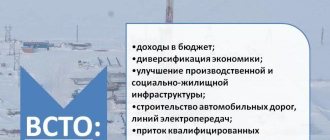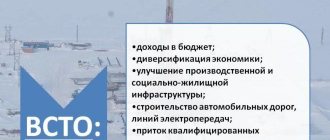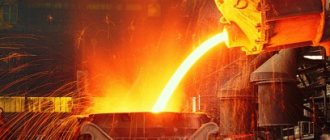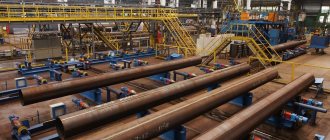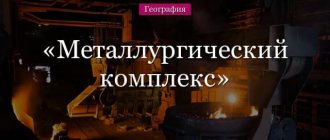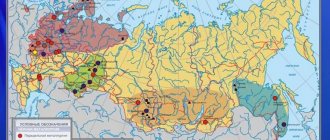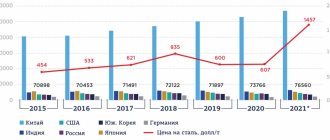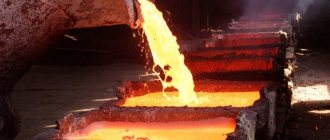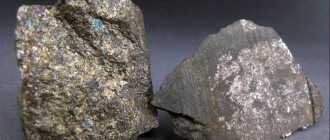Such a branch of economic activity as metallurgy includes two areas: ferrous metallurgy and non-ferrous metallurgy. Therefore, our review of the largest Russian metallurgical enterprises will be divided into two parts: Russian ferrous metallurgy enterprises and Russian non-ferrous metallurgy enterprises.
Russian ferrous metallurgy enterprises
Ferrous metallurgy includes the following sub-sectors:
1. Extraction of non-metallic raw materials (refractory clays, flux raw materials, etc.) for ferrous metallurgy. 2. Production of ferrous metals (ferrous metals include: steel, cast iron, rolled metal, metal powders of ferrous metals, blast furnace ferroalloys). 3. Pipe production (production of steel and cast iron pipes). 4.Coke and chemical production (production of coke, coke oven gas, etc.). 5.Secondary processing of ferrous metals (secondary processing includes cutting scrap and waste ferrous metals).
Products manufactured by Russian ferrous metallurgy enterprises are sold to engineering and construction organizations, and are also exported abroad.
There are several types of ferrous metallurgy enterprises:
1. Full-cycle metallurgical enterprises (engaged in the production of cast iron, steel and rolled products). 2. Pipe metallurgy enterprises (enterprises without iron smelting). 3. Small metallurgy enterprises (machine-building plants producing steel and rolled products).
The smallest metallurgical enterprises are factories; larger ones are factories. Both mills and factories can be united into holdings.
The location of Russian ferrous metallurgy enterprises depends, first of all, on proximity to deposits of iron ores and other minerals. So, for example, metallurgical plants producing iron and steel are located in areas where, firstly, iron ore deposits are nearby, and, secondly, there are a lot of forests (since charcoal is needed to reduce iron). When constructing metallurgical enterprises, the availability of electricity, natural gas and water is also taken into account.
Today there are 3 metallurgical bases in Russia:
1. Ural metallurgical base. 2. Central metallurgical base. 3. Siberian metallurgical base.
The Ural metallurgical base is engaged in production based on iron ore mined in the following deposits:
1. Kachkanar deposits (Russia). 2.Kursk magnetic anomaly (Russia). 3.Kustanay deposits (Kazakhstan).
The largest processing metallurgy enterprises of the Ural metallurgical base are: Viz-Stal LLC (Ekaterinburg; what remains of the Verkh-Isetsky Metallurgical Plant (Izhevsk; part of Mechel OJSC), Chelyabinsk Pipe Rolling Plant (part of the ChTPZ holding "), Chelyabinsk Ferroalloy Plant (the largest in Russia in the production of ferroalloys), Serov Ferroalloy Plant, Pervouralsk New Pipe Plant (part of the ChTPZ holding), Ural Pipe Plant (city of Pervouralsk), Zlatoust Metallurgical Plant, Novolipetsk Metallurgical Plant.
The Central Metallurgical Base is engaged in production based on iron ore mined in the following deposits:
1.Kursk magnetic anomaly (Russia). 2. Deposits of the Kola Peninsula (Russia).
The largest full-cycle metallurgical enterprises of the Central Metallurgical Base are: Cherepovets Metallurgical Plant (part of the group), Novolipetsk Metallurgical Plant, Kosogorsk Metallurgical Plant (Tula), Oskol Electrometallurgical Plant (Stary Oskol).
The largest processing metallurgy enterprises of the Central Metallurgical Base are: Cherepovets Steel-Rolling Plant (part of the group), Oryol Steel-Rolling Plant, Metallurgical (Elektrostal), Metallurgical (Moscow), Izhora Pipe Plant (St. Petersburg; owned), Vyksa Metallurgical Plant ( Vyksa city, Nizhny Novgorod region).
The Siberian Metallurgical Base is engaged in production based on iron ore mined in the following deposits:
1.Gornaya Shoria deposits (Russia). 2.Abakan deposits (Russia). 3. Angaro-Ilim fields (Russia).
The largest full-cycle metallurgical enterprises of the Siberian metallurgical base are: Novokuznetsk Metallurgical Plant, West Siberian Metallurgical Plant (city of Novokuznetsk), Novokuznetsk Ferroalloy Plant.
The largest processing metallurgy enterprises of the Siberian metallurgical base are: Novosibirsk Metallurgical Plant named after Kuzmin, Metallurgical (Krasnoyarsk city), Guryevsky Metallurgical Plant (part of the ITF Group holding), Petrovsk-Zabaikalsky Metallurgical Plant.
Russian non-ferrous metallurgy enterprises
Non-ferrous metallurgy includes the following production processes:
1. Mining and beneficiation of non-ferrous metal ores. 2. Smelting of non-ferrous metals and their alloys (there are two types of non-ferrous metals: heavy (copper, zinc, lead, nickel, tin) and light (aluminum, magnesium, titanium)).
The location of non-ferrous metallurgy enterprises depends on factors such as the raw material factor (proximity to raw material sources; this is the most important factor), natural factor, fuel and energy factor and economic factor. Enterprises for the production of heavy non-ferrous metals are located in close proximity to areas where raw materials are extracted (since this production does not require a large amount of energy). Enterprises producing light non-ferrous metals require large amounts of electricity, so they are located near sources of cheap energy.
The following types of non-ferrous metallurgy enterprises are located in Russia:
Read also: The diode on the switch does not light up
1. Enterprises of the copper sub-industry. 2. Enterprises of the lead-zinc sub-industry. 3. Enterprises of the nickel-cobalt sub-industry. 4. Enterprises of the tin sub-industry. 5. Enterprises of the aluminum sub-industry. 6. Enterprises of the tungsten-molybdenum sub-industry. 7. Enterprises of the titanium-magnesium sub-industry. 8. Enterprises of the rare metal sub-industry.
The largest Russian enterprises in the copper sub-industry are: Buribaevsky GOK, Gaisky GOK (part of the UMMC holding), Karabashmed, Krasnouralsk copper smelting plant, Kirovgrad copper smelting plant, Mednogorsk copper-sulfur plant (part of the UMMC holding), Ormet (owned by RAO Gazprom"), Polymetal Production (part of the UMMC holding), Safyanovskaya Copper (part of the UMMC holding), Svyatogor (part of the UMMC holding), Sredneuralsky Copper Smelter (part of the UMMC holding), Uralelectromed ( part of the UMMC holding).
The largest Russian enterprises in the lead-zinc sub-industry are: Bshkir copper-sulfur plant, Belovsky zinc plant, Gorevsky GOK, Dalpolimetal, Ryaztsvetmet, Sadonsky lead-zinc plant, Uchalinsky GOK, Chelyabinsk electrolyte-zinc plant, Electrozinc.
The largest Russian enterprises in the nickel-cobalt sub-industry are: MMC Norilsk Nickel (owned), PA Rezhnikel (owned by RAO Gazprom), Ufaleynickel, Yuzhuralnickel.
The largest Russian enterprises in the tin sub-industry are: Far Eastern Mining Company, Dalolovo (owned), Deputatskolovo, Novosibirsk Tin Plant, Khingan Tin (owned).
The largest Russian enterprises in the aluminum sub-industry are: Achinsk Alumina Refinery (part of the RusAL holding), Boguslav Aluminum Refinery (part of the SUAL holding), Belokalitvinsky Metallurgical Production Association (part of the RusAL holding), Boksitogorsk Alumina Refinery, Bratsk Aluminum Refinery (part of the RusAL holding), Volgograd aluminum smelter, Volkhov aluminum smelter, Irkutsk aluminum smelter (part of the SUAL holding), Kamensk-Ural metallurgical plant (part of the SUAL holding), Kandalaksha aluminum smelter (part of the holding "SUAL"), Krasnoyarsk Aluminum Smelter (part of the RusAL holding), Mikhalyum (part of the SUAL holding), Nadvoitsky Aluminum Smelter (part of the SUAL holding), Novokuznetsk Aluminum Smelter (part of the RusAL holding) , Samara Metallurgical Plant (part of the RusAL holding), Sayan Aluminum Plant (part of the RusAL holding), Stupino Metallurgical Company (owned by RAO Gazprom), Ural Aluminum Plant (part of the SUAL holding), Foil Rolling Plant .
The largest Russian enterprises in the tungsten-molybdenum sub-industry are: Hydrometallurg, Zhirekensky GOK, Kirovgrad Hard Alloy Plant, Lermontov Mining Company, Primorsky GOK, Sorsk GOK.
The largest Russian enterprises in the titanium-magnesium sub-industry are: AVISMA, VSMPO, Solikamsk Magnesium Plant.
The largest Russian enterprises in the rare metal sub-industry are: Zabaikalsky GOK, Orlovsky GOK, Sevredmet (owned by ZAO FTK).
Added 12.08.2009;
Ferrous metallurgy is a branch of heavy industry that produces various ferrous metals. It covers the mining of iron ore and the production of ferrous metals - cast iron - steel - rolled products. Cast iron and steel are used in mechanical engineering, rolled steel in construction (beams, roofing iron, pipes) and transport (rails). The military-industrial complex is a major consumer of rolled steel. Russia fully meets its needs for ferrous metallurgy products and exports them.
Steel consumption per unit of production in mechanical engineering in Russia exceeds this figure in other developed countries. With economical use of metal, Russia could increase the size of its exports.
Cast iron is smelted in blast furnaces - huge and expensive structures made of refractory bricks. The raw materials for the production of cast iron are manganese, iron ore, refractories (limestone). Coke and natural gas are used as fuel. 95% of coke is produced by metallurgical plants.
Steel is smelted in open hearth furnaces, converters and electric furnaces. The raw materials for steel production are cast iron and scrap metal. The quality of steel increases with the addition of non-ferrous metals (tungsten, molybdenum). Rolled steel is produced on rolling machines.
The structure of the ferrous metallurgy stimulated the development of intra- and inter-industry plants. Combination is the unification at one enterprise (plant) of several technologically and economically related industries of various industries. Most metallurgical plants in Russia are plants that include three stages of metal production: cast iron - steel - rolled products (+ coke plant, + thermal power plant or nuclear power plant, + production of building materials, + hardware plant).
For every ton of cast iron, 4 tons of iron ore, 1.5 tons of coke, 1 ton of limestone, and a large amount of gas are consumed, i.e., ferrous metallurgy is a material-intensive production that is associated with raw materials or fuel sources (coke). Placement factors:
Therefore, full-cycle enterprises are located: at iron ore or coke; at sources of raw materials and coke; between coke and raw materials (Cherepovets Metallurgical Plant). After the collapse of the USSR, 60% of ferrous metallurgy remained in Russia (the majority remained in Ukraine). 50% of rolled products and 60% of steel are produced using outdated equipment.
The country's prospects are connected with technical re-equipment and the latest technologies. We are talking about modernizing existing enterprises. It is planned to replace open-hearth steel production with new production methods - oxygen-converter and electric steelmaking at factories in the Urals and Kuzbass. Steel production using the converter method is increasing up to 50%. Types of enterprises:
Read also: What is iron oxide
1) Plant - full cycle - cast iron - steel - rolled products.
2) Pipe metallurgy enterprises - steel - rolled products. Such enterprises smelt steel from scrap metal and are located in large mechanical engineering centers.
3) Blast furnace enterprises (production of cast iron only). There are few of them. These are mainly factories in the Urals.
4) Small metallurgy with the production of steel and rolled products at machine-building plants.
5) Pipe factories.
6) Production of ferroalloys - iron alloys with alloying metals (manganese, chromium, tungsten, silicon).
Due to high electricity costs - 9000 kW/h per 1 ton of products, ferrous metallurgy enterprises gravitate towards cheap sources of electricity, combined with the resources of alloying metals, without which the development of high-quality metallurgy is impossible (Chelyabinsk, Serov - Ural).
In 1913, Russia ranked 5th in the world (USA, Germany, England, France) in iron ore mining and metal production. 1980 – 1990 – one of the first places in the world in iron ore mining and first in steel and cast iron smelting. Now Russia has been pushed aside by Japan and the USA.
Russia is fully provided with raw materials for ferrous metallurgy, except for manganese ores, which Ukraine is rich in. Russia has 40% of the world's iron ore reserves. 80% of iron ore is mined by open pit mining. Russia exports 20% of its ore.
Geography of iron ore deposits:
In the European part, KMA is rich in iron ore. It contains ores rich in content (iron is up to 60%), which do not require beneficiation.
In the Urals - the Kachkanar group of deposits. There are large reserves of iron ore, but it is poor in iron (17%), although it can be easily enriched.
Eastern Siberia - Angara-Ilimsky basin (near Irkutsk), Abakan region.
Western Siberia - Mountain Shoria (south of Kemerovo region).
Northern region – Kola Peninsula – Kovdorskoye and Olenegorskoye deposits; Karelia - Kostomuksha.
There are ores in the Far East.
Geography of manganese deposits:
Western Siberia - Usinsk (Kemerovo region).
Historically, ferrous metallurgy originated in the central part of the country. Starting from the 18th century, ferrous metallurgy production appeared in the Urals. The development of capitalism in Russia and the successful combination of iron ore with coal and manganese, as well as the favorable territorial and geographical position in relation to the main areas of metal consumption, brought the south to the fore (Donbass and the Dnieper region of Ukraine).
Ferrous metallurgy bases:
1) Ural
– produces 46% of metal. Imported coke from Kuzbass and Karaganda is used. Iron ore – Kachkanar group of deposits (north of the Sverdlovsk region) + Sokolovsko-Sarbaiskoe deposit (Kustanai region) + KMA. Manganese - from the Polunochnoe deposit (north of the Sverdlovsk region). Western slopes of the Urals – pigment metallurgy. The eastern slopes are plants created in Soviet times. Combines - Nizhny Tagil (Sverdlovsk region), Chelyabinsk, Magnitogorsk (Chelyabinsk region), the city of Novotroitsk (Orsko-Khamilovsky plant). They use their own alloying metals. Particle metallurgy – Yekaterinburg (Verkhne-Isetsky plant), Zlatoust (Chelyabinsk region), Chusovoy (Perm region), Izhevsk. Scrap metal is used. Pipe factories - Chelyabinsk, Pervouralsk (Sverdlovsk region). Ferroalloys – Chelyabinsk, Chusovoy (Perm region).
2) Center
– produces 20% metal. Central region + Central Black Earth region + Northern region. In the future it will become one of the main metallurgical bases. Coke is imported from the eastern wing of Donbass, the Pechora basin, and Kuzbass. Iron ore is from KMA, manganese is from Nikopol (Ukraine). Scrap metal is used. Full cycle – Novotulsky, Novolipetsk plants. Within the KMA, the production of metallized pellets arose together with Germany. On their basis, domain-free electrometallurgy was created. Stary Oskol - Oskol Electrometallurgical Plant. Conversion plants - Moscow (“Hammer and Sickle”, “Electrostal”). In recent years, the production of cold-rolled strip (steel rolling plants) has been created. The northern economic region is the Cherepovets plant, located between the iron ore of Karelia (Kostomuksha) and the Kola Peninsula (Olenegorsky, Kovdorsky) and the coke-Pechora basin. It supplies products mainly to St. Petersburg.
3) Siberia and Far East
– 13% production of ferrous metals. Combines – Novokuznetsk (Kuznetsk Metallurgical Plant), 20 km from Novokuznetsk (West Siberian Metallurgical Plant). Both enterprises use Kuzbass coke; iron ore from Mountainous Shoria, Khakassia and the Angara-Ilim basin; manganese from the Usinsk deposit. Particle metallurgy – Novosibirsk, Krasnoyarsk, Petrovsk-Zabaikalsky (Chita region), Komsomolsk-on-Amur. Ferroalloys – Novokuzensk. In the future, it is planned to create ferrous metallurgy plants on the small BAM in Taishet.
Pipe metallurgy enterprises are located outside the small BAM.
Northern Caucasus – Krasny Sulim, Taganrog (Rostov region).
Volga-Vyatka region - Vyksa River, Kulebaki (Nizhny Novgorod region).
Far East - Komsomolsk-on-Amur.
Ukraine
.
The former Southern Metallurgical Base, which ranked 2nd in terms of volume, production, production concentration and combination. Cox is local (Donbass). Iron ore – Krivoy Rog. Manganese – Nikopol. The base is divided into 3 districts
:
Read also: Alloy grade sch25 is
1. Donbass
. Focuses on Donbass coke, Krivoy Rog iron ore, and Nikopol manganese.
General characteristics of the metallurgical complex
What are mining and metallurgical complexes? This is a set of enterprises that are engaged in mining, beneficiation, metal smelting, rolled metal production and processing of secondary raw materials. The following industries are part of the metallurgical complex:
- Ferrous metallurgy , which deals with the smelting of steel, cast iron and ferroalloys;
- Non-ferrous metallurgy , which produces light (titanium, magnesium, aluminum) and heavy metals (lead, copper, tin, nickel).
Rice. 1 Metallurgical plant
The current state of the domestic metallurgy complex
The situation in Russia's oldest industry is assessed as difficult. Despite low production costs compared to other metal-producing countries, there are tendencies to delay production rates and financial problems. In the last decade, a number of plants have been shut down.
Since the crisis of 2009, there has been a decline in aluminum production, despite the fact that its consumption in other industrialized countries of the world is many times higher than the demand in ours. With fairly high prices for metals and an increase in their consumption in the world, the financial and economic situation of Russian metallurgical enterprises is deteriorating.
Principles of business location
Enterprises of the mining and metallurgical complex are not located randomly. They depend on the following factors of metallurgy location:
- Raw materials (physical and chemical characteristics of ores);
- Fuel (what type of energy must be used to produce metal);
- Consumer (geography of placement of raw materials, main energy sources and availability of transport routes).
Rice. 2 Fuel factor of metallurgy location
Lead-zinc industry in Russia
The country ranks 3rd in terms of lead reserves, the main part - more than 68% - is located in the south of Eastern Siberia. Enterprises of the zinc industry gravitate towards deposits, since the zinc content in the ore is from 2% to 4% and it is not transportable. More than half of the zinc is exported. Full metal processing enterprises:
PJSC Chelyabinsk Zinc Plant uses imported concentrate.
JSC "Electrolit" in Vladikavkaz produces:
- cadmium;
- zinc;
- sulfuric acid.
Lead concentrate is obtained in Belovo, and zinc is smelted here. Zinc concentrates are produced in Sredneuralsk and Nerchinsk.
Non-ferrous metallurgy
Based on their purpose and chemical and physical characteristics and properties, non-ferrous metals are divided into:
- Heavy (copper, lead, tin, zinc, nickel);
- Lightweight (aluminum, titanium, magnesium);
- Precious (gold, silver, platinum);
- Rare (zirconium, indium, tungsten, molybdenum, etc.)
Non-ferrous metallurgy is a complex of enterprises that is engaged in the extraction, enrichment and metallurgical processing of non-ferrous, precious and rare metal ores.
In this chain, aluminum, copper, lead-zinc, tungsten-molybdenum and titanium-magnesium industries are distinguished. In addition, this also includes enterprises producing precious and rare metals.
Metallurgical bases of Russia
Depending on the focus of the metallurgical complex, enterprises are located close to the sites of extraction of raw materials necessary to ensure their operation. Since deposits of ore, or fuel for its smelting, are located in certain regions of the country, there are entire groups of metallurgical plants and combines around them. These enterprises use common raw materials and have the same production direction, so they are conventionally combined into groups called metallurgical bases. On the territory of Russia three large groups can be distinguished:
- Central - Ural - Siberian.
Since these territories contain ore deposits of different composition, different degrees of supply with fuel and other production needs, the target orientation, capacity and structure of the bases are different. In addition, in these regions, mining and processing started at different times, which significantly affected not only the scale of production capacity, but also the depletion of the mines from which mining is carried out.
Central metallurgical base
This group of enterprises is engaged in active production of ferrous metals. The resource of these enterprises is very large, since nearby territories have significant reserves of raw materials in the form of iron ore. Production covers not only the smelting of extracted ore from the deposits of the Kursk magnetic anomaly, but also processes imported raw materials and ferrous metal scrap.
The territory of the Central Base is characterized by the occurrence of ore quite close to the surface, which made it possible to establish open-pit mining.
This technology allows for greater productivity in each mine. This significantly reduces the cost, which has a positive effect on the development of the entire metallurgical complex of the Central Base.
Direct production is carried out in the Kursk and Belgorod regions. The cost of production is 1 ton. of ore ready for processing is almost two times lower than at other production deposits in Ukraine and Kazakhstan. The central base provides 80 million tons. raw ore.
This figure accounts for about 40% of production throughout the country. Its convenient location allows us not only to export our products, but also to import raw materials for processing. These facts have a positive effect on the cost of production, making it competitive in the market.
The group includes enterprises of a full metallurgical cycle, which are equipped with production capacity for processing raw materials into finished products in the form of rolled metal and other products. Among them are: Novotula plant, Novolipetsk metallurgical plant, metallurgical plant, Oskol electrometallurgical plant for direct reduction of iron. These enterprises have a high degree of self-sufficiency and play a key role in the Russian economy.
The central base also includes the territory of the North of the European part of the Russian Federation. There are ore deposits here amounting to 5% of the total reserves. Direct metal extraction as a percentage of the All-Russian is 21%. This is provided by a group of enterprises such as: Cherepovets Metallurgical Plant, Olenegorsk, Kovdor and Kostomuksha Mining and Processing Plants. The ore mined here has a small percentage of impurities, which allows it to be processed into high-quality high-carbon steel.
Ural metallurgical base
It has a developed structure, which allowed it to become one of the largest metalworking complexes in the CIS countries. Every day, 52% of cast iron and ferrous metals, 56% of steel of the total productivity in the country are smelted here. The largest production of non-ferrous metals in the Russian Federation has been established in the Urals. Such scale is explained by the fact that these industries are the oldest in Russia, so they have a long history of development. Due to the shortage of fuel in this region, the supply of Kuznetsk coal has been established, which allows it to fully cover demand. Due to the severe depletion of their own deposits, enterprises process ore from Kazakhstan, Karelia and the Kursk magnetic anomaly. These measures allow Ural metallurgy to maintain its leadership in productivity.
Direct mining of own ore is actively taking place in the Sverdlovsk and Chelyabinsk regions. Large-scale production has been established at the Kachkanar Mining and Processing Plant and the Bakal Mining Administration. These enterprises are quite old and have a long history, and have been supporting the work of the entire region for many years.
The most effective centers of the country's ferrous metallurgy are located precisely in the Urals, these are: Magnitogorsk, Nizhny Tagil, Chelyabinsk, Serov, Yekaterinburg, etc. It should be noted that the largest iron production enterprise in Europe is the Magnitogorsk Iron and Steel Works, which is also part of the Ural Metallurgical Group bases. The Urals are characterized by a high concentration of these enterprises. But their activities are not limited to smelting, since the region produces pipes for oil and gas pipelines, which is a large area that requires a significant share of the metals produced. Thus, on the territory of the Ural base, a system of metal consumption has been developed by manufacturing pipes, fittings and other products from it, which cover demand not only within the country, but are also exported.
Siberian metallurgical base
This is a relatively young group that is at the formation stage. Despite the insignificant degree of development, in comparison with Ural enterprises, mining and processing activities are very promising. 21% of the country’s total reserves are hidden in the bowels of the earth in this region, and there are not yet very many factories and plants for their extraction. As a percentage, 15% of cast iron and finished rolled products are produced. The operation of the enterprises is ensured by the Angaro-Ilim basin, Khakassia and Mountain Shoria. For smelting, fuel is used from the Kuznetsk coal basin, which, as noted earlier, supports Ural production.
The main ones in the region are the Kuznetsk and West Siberian metallurgical plants. Due to the incomplete filling of the raw material extraction capacity, there are prospects for the construction of additional centers on the territory of the Siberian Metallurgical Base. In particular, this can be done by expanding the Taishet and Barnaul metallurgical plants.
In light of the active formation of the South Yakut complex, there are prospects for the development of this activity in the Far East. The remoteness of the region is an obstacle to large-scale transportation of raw materials, so it is planned to create a full processing cycle directly near the extraction site. This will reduce the cost of finished products, since there will be no need for additional transportation costs.
With the development of the economy, associations and holdings were formed to ensure the sale of products and the supply of raw materials necessary for production from other regions or countries. Their structure includes factories and combines, which are located in different metallurgical bases of the country. Vivid examples of such a union are the Metalloinvest holding, Severstal, Evraz Group S.A. and etc.
Non-ferrous metallurgy centers in Russia
The centers of the aluminum industry are Bratsk, Krasnoyarsk, Sayansk and Novokuznetsk. Large aluminum smelters located in these cities are developed on the basis of their own raw materials from the Urals, the North-Western region and Siberia, as well as imported ones. This production is quite energy-intensive, so the enterprises are located near hydroelectric and thermal power plants.
The main center of the copper industry of our country is the Urals. Enterprises use local raw materials from the Gaisky, Krasnouralsky, Revdinsky and Sibaysky deposits.
The country's lead-zinc industry depends on the extraction of polymetallic ores, which is why it is located close to their mining sites - Primorye, the North Caucasus, Kuzbass and Transbaikalia.
Rice. 3 Gold mining in Chukotka
Severstal
The plant in the Vologda region (Cherepovets) employs about 50,000 people. The company is engaged in steel smelting and mining (the company operates two mining and processing plants). The metallurgical plant was founded in 1955. As of 2022, it ranks second among the entire country in terms of steel production.
The company produces steel pipes and rolled metal for various industries. About 11.6 million tons of steel are produced annually, and these figures are regularly increasing. Currently, the plant is establishing the production of new types of products and expanding its sales markets. Products are supplied to industries such as carriage building, automotive manufacturing, as well as for the development of agricultural machinery.
Problems and prospects
There are problems in every industry. The metallurgical complex is no exception. Among the main problems of ferrous and non-ferrous metallurgy, the following can be identified:
- high energy consumption;
- low capacity of the domestic market;
- high level of depreciation of fixed production assets;
- shortage of certain types of raw materials;
- destruction of the process of reproduction of raw materials and ore reserves;
- technological backwardness and insufficient introduction of new technologies;
- shortage of professional personnel.
But all these issues can be resolved. Russia continues to be a major player in the global metallurgical products market. The share of Russian metallurgy in world production accounts for more than 5% of steel, 11% of aluminum, 21% of nickel, and more than 27% of titanium. The main indicator of the competitiveness of Russian metallurgy on the foreign market is that the country maintains and even expands its export capabilities.
Nizhny Tagil Iron and Steel Works
lineartworks.ru
The plant's workforce is about 20,000 people. Production facilities are located in the Urals - in the city of Nizhny Tagil. The enterprise has a high level of equipment, allowing it to produce products of excellent quality.
The main direction is the production of rolled metal for the needs of the city's carriage-building enterprises. In addition, products are sent to other regions of Russia. We also carry out deliveries to other branches of mechanical engineering and for the public utilities sector. The plant is actively developing new technologies, steel grades, and rolled products that can be used in pipeline construction.
What have we learned?
Today we learned what is meant by the term “metallurgical complex”. This industry is divided into ferrous and non-ferrous metallurgy. The location of enterprises for mining, ore beneficiation, metal smelting and rolled products production has its own characteristics and depends on three factors: raw materials, fuel and consumer. There are three metallurgical bases operating and developing in the Russian Federation: Central, Ural and Siberian.
Previous
GeographyForest industry in Russia and the world, location factors and problems
Next
Geography Factors for the location of the chemical industry - table
